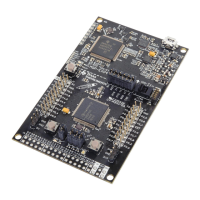44
TMS570LS0714
SPNS226E –JUNE 2013–REVISED NOVEMBER 2016
www.ti.com
Submit Documentation Feedback
Product Folder Links: TMS570LS0714
System Information and Electrical Specifications Copyright © 2013–2016, Texas Instruments Incorporated
6.2.3 Supply Filtering
The VMON has the capability to filter glitches on the VCC and VCCIO supplies.
The following table shows the characteristics of the supply filtering. Glitches in the supply larger than the
maximum specification cannot be filtered.
Table 6-2. VMON Supply Glitch Filtering Capability
PARAMETER MIN MAX UNIT
Width of glitch on VCC that can be filtered 250 1000 ns
Width of glitch on VCCIO that can be filtered 250 1000 ns
6.3 Power Sequencing and Power-On Reset
6.3.1 Power-Up Sequence
There is no timing dependency between the ramp of the VCCIO and the VCC supply voltage. The power-
up sequence starts with the I/O voltage rising above the minimum I/O supply threshold, (see Table 6-4 for
more details), core voltage rising above the minimum core supply threshold and the release of power-on
reset. The high-frequency oscillator will start up first and its amplitude will grow to an acceptable level. The
oscillator start-up time is dependent on the type of oscillator and is provided by the oscillator vendor. The
different supplies to the device can be powered up in any order.
The device goes through the following sequential phases during power up.
Table 6-3. Power-Up Phases
Oscillator start-up and validity check 1032 oscillator cycles
eFuse autoload 1160 oscillator cycles
Flash pump power-up 688 oscillator cycles
Flash bank power-up 617 oscillator cycles
Total 3497 oscillator cycles
The CPU reset is released at the end of the above sequence and fetches the first instruction from address
0x00000000.
6.3.2 Power-Down Sequence
The different supplies to the device can be powered down in any order.

